From pricing precision to contract compliance—bridging the gap for faster, smarter deals.
CPQ (Configure-Price-Quote) and CLM (Contract Lifecycle Management) systems serve different yet complementary functions in the sales process. CPQ handles product configuration, pricing rules, and quote generation, while CLM manages contract creation, execution, and ongoing compliance. When integrated properly, they create a seamless quote-to-contract workflow that reduces errors by 42%, accelerates deal closure by 27%, and ensures consistency across all customer-facing documents. This guide explores their relationship, integration techniques, and how Mobileforce’s solutions enhance this critical business process.
“The space between a quote and a contract is where deals go to die.” This sobering observation from a Gartner analyst captures the high stakes of the quote-to-contract process in today’s business landscape.
In the complex dance of B2B sales, two critical systems often operate in parallel worlds: Configure-Price-Quote (CPQ) and Contract Lifecycle Management (CLM). The first helps sales teams configure complex products, apply pricing rules, and generate accurate quotes. The second enables legal teams to create, review, execute, and manage contractual agreements. When these systems don’t talk to each other effectively, the consequences can be severe.
According to recent research by Forrester, organizations with disconnected CPQ and CLM systems experience an average contract delay of 3.4 weeks, resulting in extended sales cycles and delayed revenue recognition. The financial impact is substantial—World Commerce & Contracting reports that poor contract management costs companies an average of 9.2% of annual revenue.
Beyond these financial considerations lies a more fundamental challenge: maintaining consistency between what’s quoted and what’s contracted. This alignment isn’t just about operational efficiency—it’s about maintaining trust with customers and ensuring that the organization can deliver on its promises while protecting its interests.
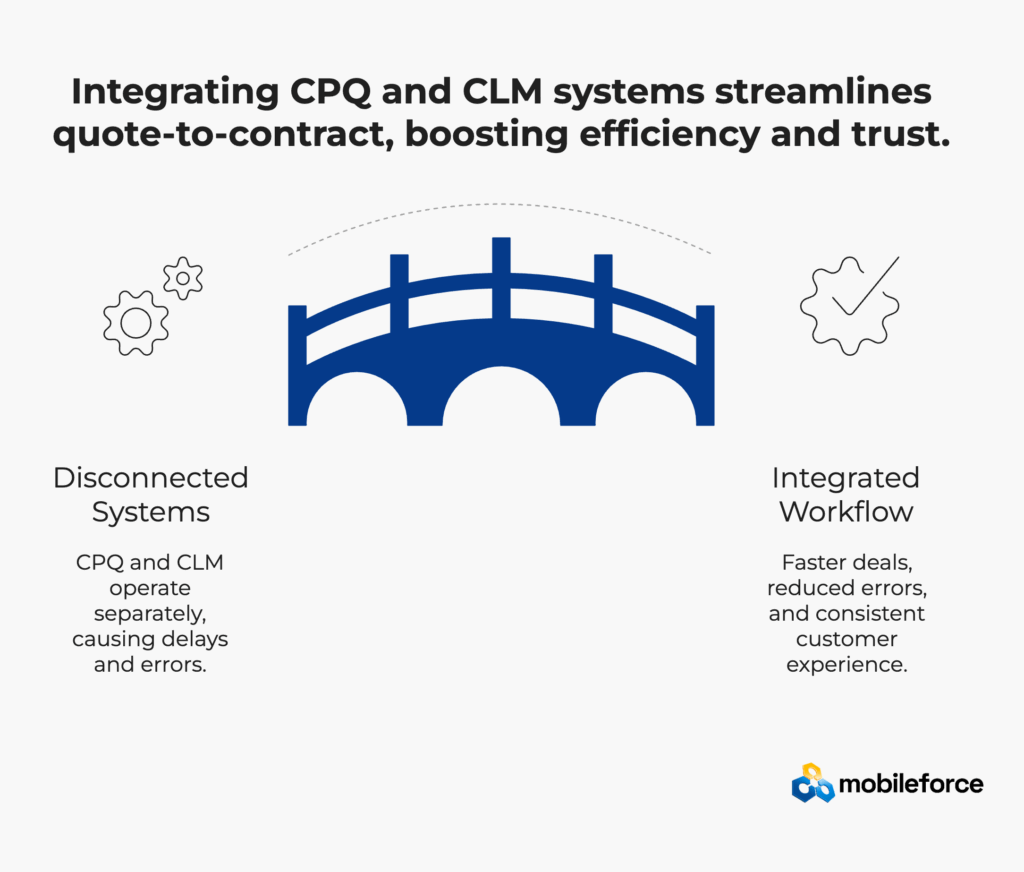
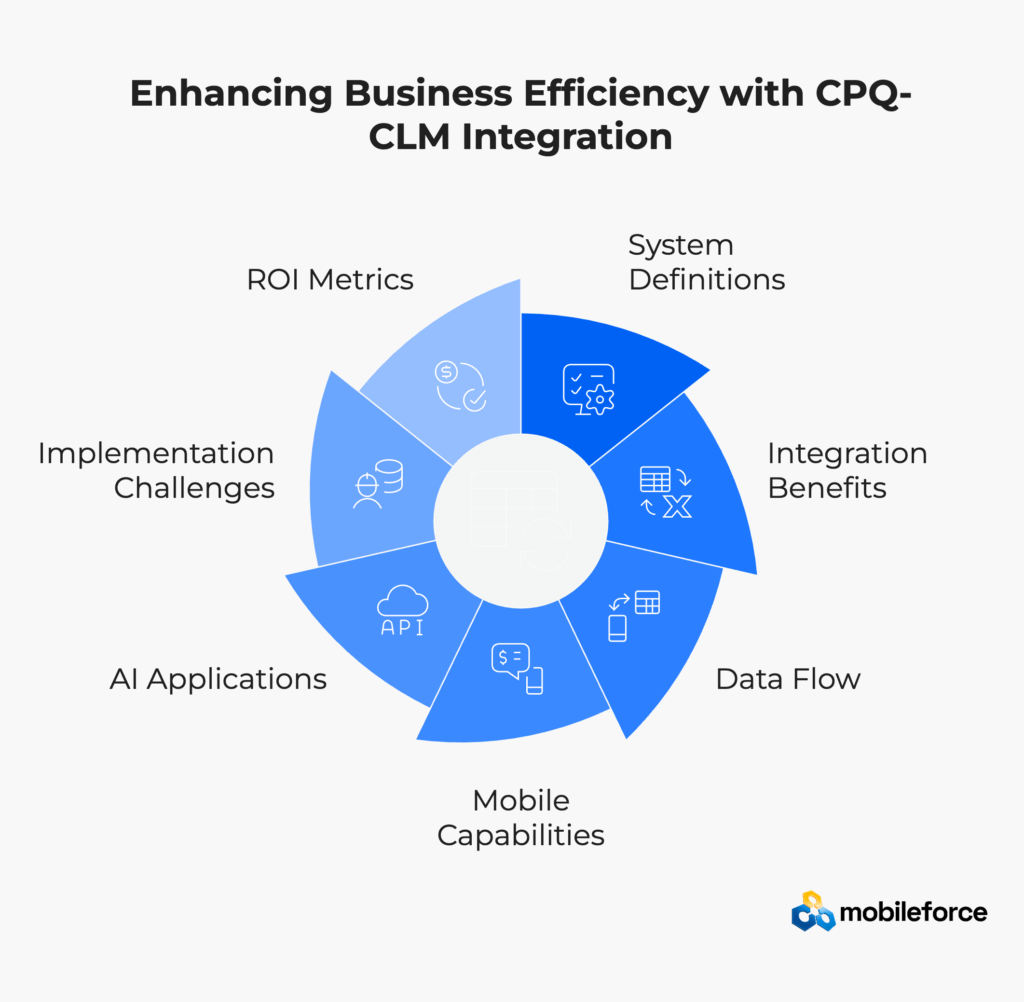
Understanding the distinct yet complementary roles of CPQ and CLM systems is essential before exploring their integration. While both play crucial roles in the revenue process, they serve different functions and typically involve different stakeholders.
CPQ systems excel at handling the complex configuration of products and services, applying appropriate pricing models, and generating professional quotes. Originally developed to help sales teams manage complex product offerings, modern CPQ systems have evolved into sophisticated platforms that can:
As Mobileforce’s Field Service Management guide explains, “CPQ systems streamline the sales process by eliminating configuration errors and ensuring pricing accuracy—critical capabilities when field technicians need to generate quotes on-site.”
The primary users of CPQ systems are typically sales representatives, sales operations teams, and occasionally field service technicians who need to generate quotes during customer visits.
Contract Lifecycle Management systems, by contrast, focus on the creation, execution, and management of legal agreements. CLM systems typically handle:
CLM systems primarily serve legal teams, contract administrators, and procurement professionals who need to ensure contractual compliance and manage risk.
Aspect | CPQ | CLM |
Primary Function | Product configuration, pricing calculation, quote generation | Contract creation, execution, repository, compliance |
Key Outputs | Quotes, proposals, configurations | Contracts, amendments, obligations |
Lifecycle Stage | Pre-contract (sales cycle) | Contract execution and post-execution |
Primary Users | Sales reps, sales operations, field technicians | Legal teams, contract administrators, procurement |
Business Impact | Revenue acceleration, pricing accuracy | Risk mitigation, compliance, relationship management |
Integration Points | Product catalog, CRM, e-commerce | CRM, ERP, e-signature, CPQ |
Ready to see how an integrated CPQ-CLM solution can transform your sales process? Schedule a Mobileforce demo today to explore possibilities tailored to your business needs.
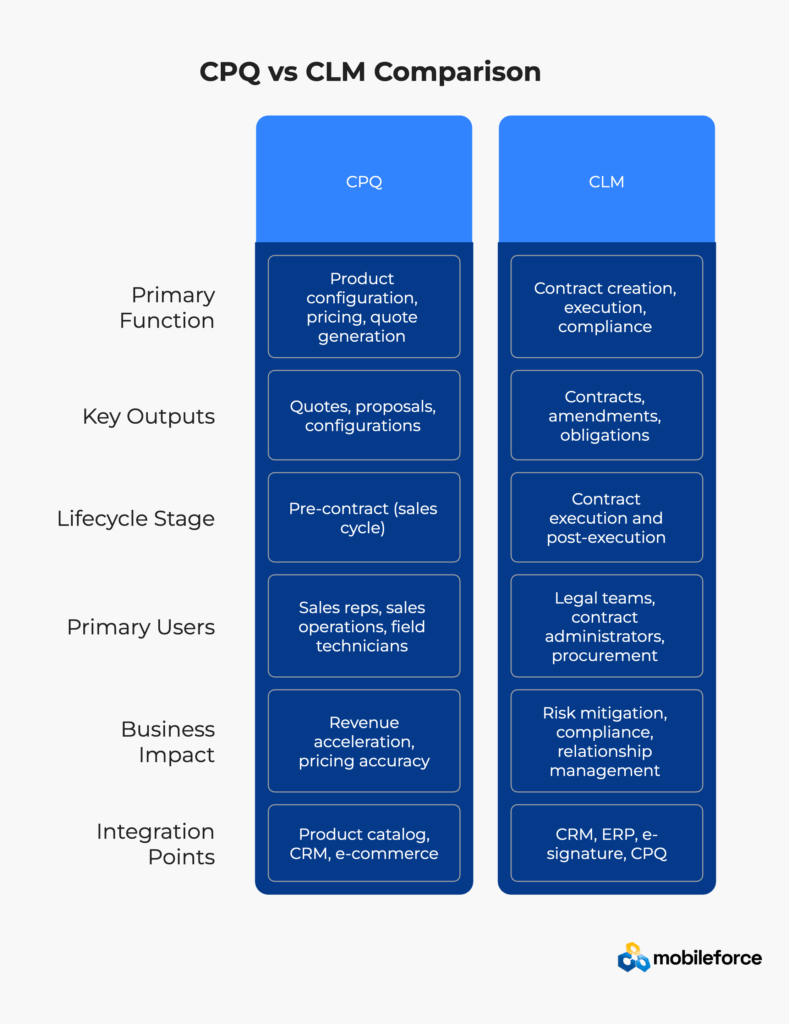
A well-designed quote-to-contract workflow creates a seamless handoff between sales and legal processes. This continuity ensures that what’s promised in the quote is accurately reflected in the contract, eliminating discrepancies that can lead to disputes, delivery issues, or compliance problems.
In an optimized environment, the quote-to-contract process follows a logical progression:
According to Mobileforce’s approach to configure-price-quote solutions, “The handoff from quote to contract represents a critical moment where sales intent must translate perfectly into legal obligation—any disconnect creates risk for both parties.”
The most significant challenges typically occur at the transition points between CPQ and CLM systems:
Organizations with field service operations face additional challenges. As Mobileforce notes in their field service automation resources, “When technicians generate quotes on-site, those quotes must seamlessly flow into contract processes—even when working in offline environments.”
Integration Level | Quote Acceptance to Contract | Contract Modifications | Approval Process | Time to Contract |
Manual (No Integration) | Manual reentry of all quote data | Separate, uncoordinated processes | Duplicate approvals required | 3-4 weeks |
Basic Integration | Automated data transfer with manual verification | Manual synchronization | Partial approval sharing | 1-2 weeks |
Advanced Integration | Seamless transfer with real-time validation | Bidirectional synchronization | Unified approval workflow | 2-3 days |
Mobileforce Solution | Field-to-contract capability with offline support | Mobile-enabled adjustments with sync | Context-aware approvals | Same day possible |
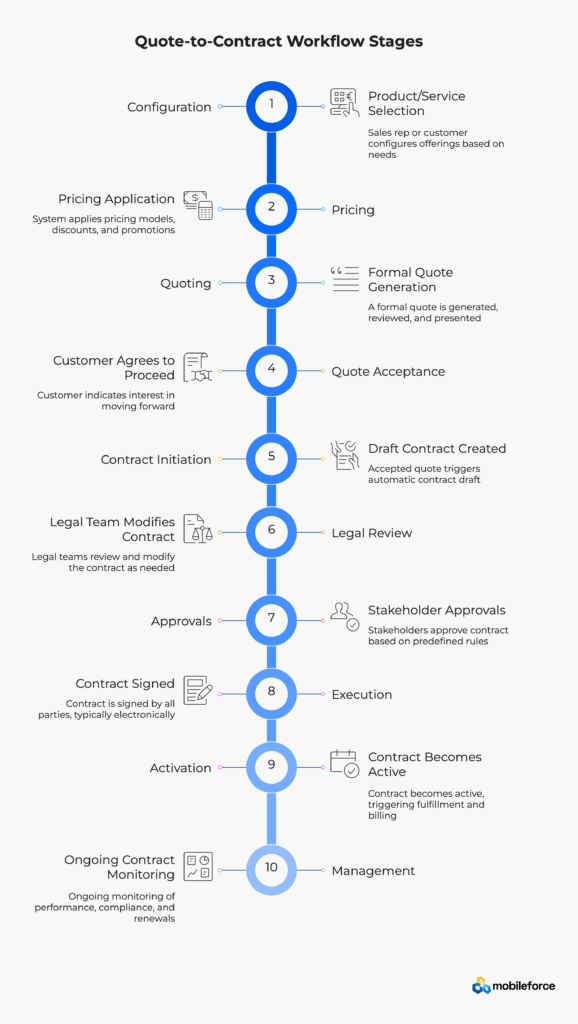
The business case for connecting CPQ and CLM systems extends beyond operational efficiency. Organizations that have successfully integrated these systems report significant improvements across multiple dimensions.
Accelerated Revenue Recognition: According to Aberdeen Group research, companies with integrated CPQ and CLM systems close deals 27% faster than those with disconnected systems. This acceleration directly impacts revenue recognition timing and cash flow.
Error Reduction: The same research indicates a 42% reduction in contract errors when quote data flows automatically into contracts. Manual rekeying of complex product configurations and pricing is a notorious source of errors.
Compliance Improvements: World Commerce & Contracting reports that organizations with integrated systems experience 55% fewer compliance issues related to contractual obligations.
Resource Efficiency: Sales operations teams report spending 68% less time on quote-to-contract administration when systems are properly integrated, according to Forrester research.
Beyond these internal benefits, integrated quote-to-contract processes create a more seamless customer experience:
Consistency: Customers receive consistent information throughout their journey, from initial quote through contract execution.
Transparency: Changes made during negotiation are reflected consistently across all documents.
Speed: Faster contract turnaround means customers can implement solutions sooner.
As Mobileforce’s customer experience platform overview explains, “The quote-to-contract process is a critical touchpoint in the customer journey—one that shapes perceptions about how easy it will be to do business with your organization.”
Tired of manual handoffs between quoting and contracting? Schedule a Mobileforce demo to see how our integrated solutions can eliminate these friction points.
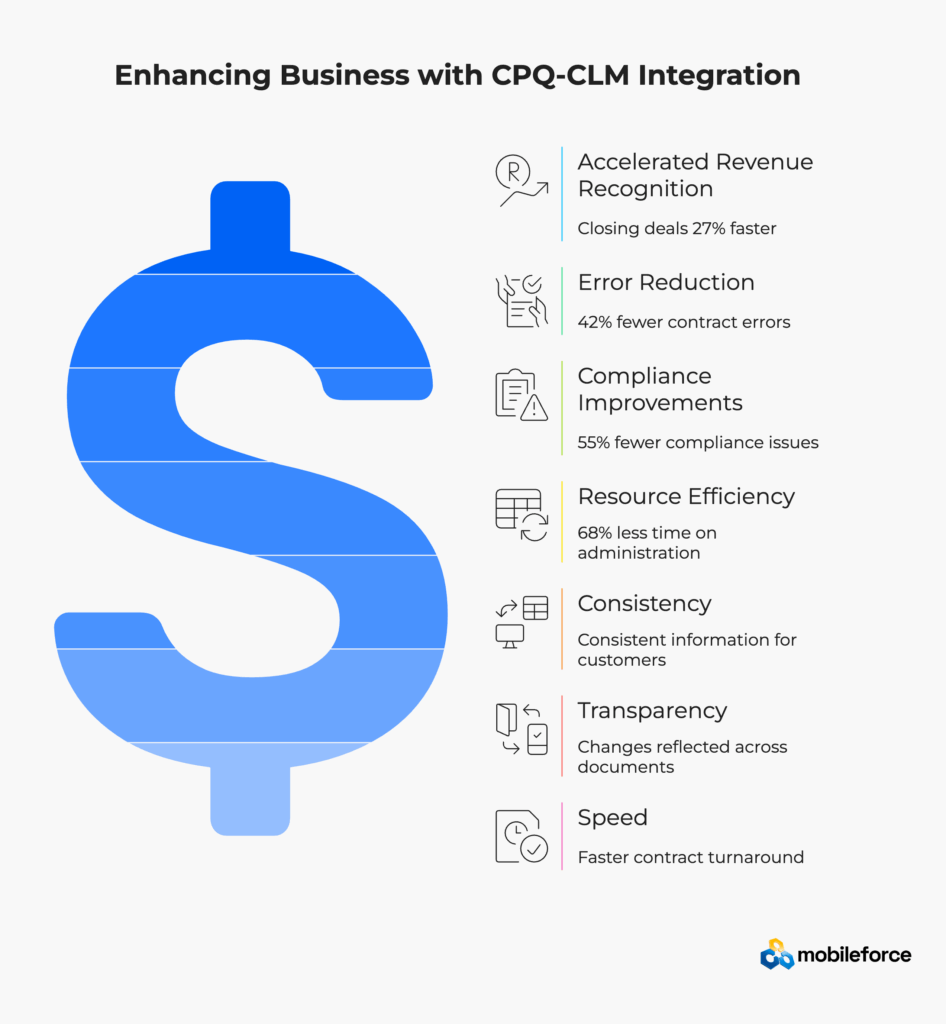
Successfully connecting CPQ and CLM systems requires careful consideration of data models, integration patterns, and synchronization logic. While the specific approach will vary based on the systems involved, certain principles apply universally.
Effective integration starts with mapping the core data objects that must flow between systems:
Quote Objects: The quote itself, line items, pricing details, terms and conditions, approval status
Contract Objects: Contract templates, clauses, obligations, approval workflows, execution status
Shared Objects: Customer information, product details, pricing models, discounts, payment terms
The challenge lies in maintaining the relationships between these objects. For example, a single quote line item might translate into multiple contract clauses, each with specific obligations.
Several technical approaches can facilitate CPQ-CLM integration:
API-Based Integration: Modern CPQ and CLM systems typically offer robust APIs that enable real-time data exchange. This approach provides the most flexibility but requires custom development.
Middleware Solutions: Integration platforms like MuleSoft, Boomi, or Workato can serve as intermediaries between CPQ and CLM systems, handling data transformation and workflow orchestration.
Native Integrations: Some vendors offer pre-built connectors between their CPQ and CLM offerings or with popular third-party solutions.
Database-Level Integration: In some cases, especially with legacy systems, database-level integration may be necessary to capture and synchronize data.
For organizations with field operations, mobile capabilities add another dimension to integration requirements. Mobileforce’s mobile sales enablement platform is specifically designed to address these challenges:
“Field teams need the ability to generate quotes in offline environments while ensuring those quotes seamlessly flow into contract processes once connectivity is restored. This requires sophisticated synchronization logic and conflict resolution mechanisms.”
Several challenges frequently arise during CPQ-CLM integration:
Data Mapping Complexity: Field mappings between systems can be complex, especially for custom fields and calculated values.
Version Control Issues: When quotes or contracts are modified, keeping both systems in sync becomes challenging.
Approval Workflow Conflicts: Different approval requirements in each system can create confusion and delays.
User Experience Fragmentation: Without careful design, users may need to navigate multiple interfaces to complete processes.
Organizations that successfully navigate these challenges typically adopt a phased approach, beginning with basic data synchronization and progressively adding more sophisticated capabilities.
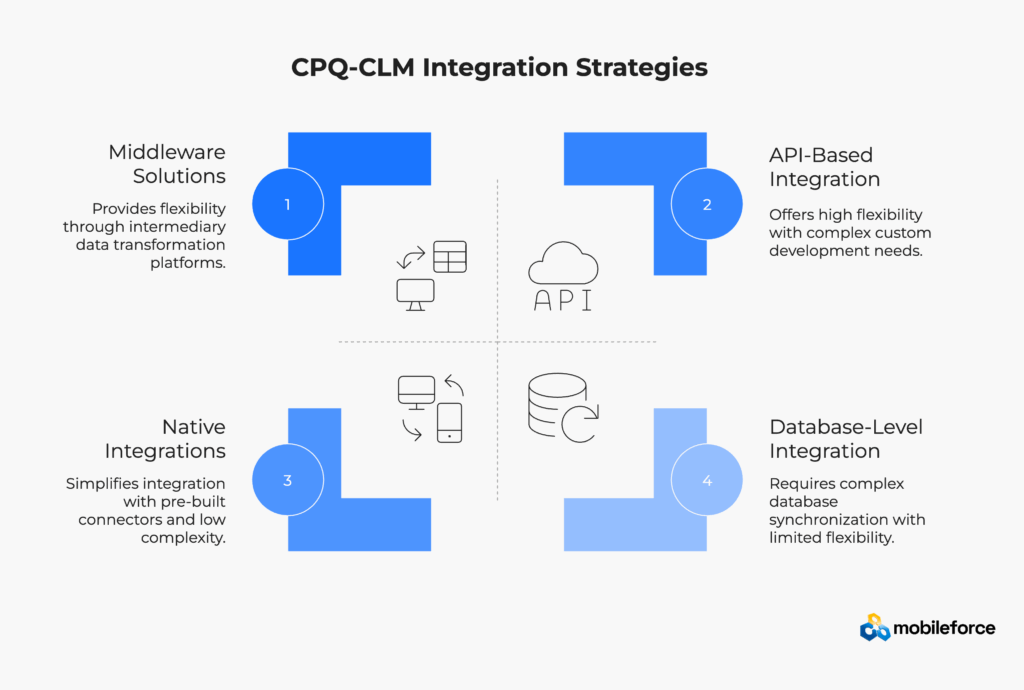
One of the most powerful benefits of CPQ-CLM integration is the ability to automate the translation of commercial terms into legal language. This capability bridges the gap between sales and legal teams, ensuring that what’s promised in quotes is accurately reflected in contracts.
Modern CLM systems maintain libraries of pre-approved clauses and contract templates. When integrated with CPQ, these systems can automatically select appropriate clauses based on the products, services, and terms specified in the quote.
For example:
According to legal operations professionals surveyed by Gartner, organizations with automated clause selection report 76% faster contract creation times compared to manual methods.
Advanced integrations employ conditional logic to determine which clauses should be included based on quote characteristics:
IF Product_Category = “Hardware” THEN Include_Clause(“Hardware_Warranty”)
IF Discount > 20% THEN Route_For_Additional_Approval
IF Service_Level = “Premium” THEN Include_Clause(“Premium_SLA”)
This approach ensures consistency while maintaining flexibility for different commercial scenarios.
Automated contract generation doesn’t just improve efficiency—it also reduces risk. By ensuring that only pre-approved clauses are used, organizations maintain legal compliance while reducing the potential for unauthorized terms.
Mobileforce’s approach to compliance automation emphasizes this dual benefit: “When field representatives can generate quotes that automatically translate into compliant contracts, organizations achieve both speed and risk mitigation.”
Capability | Without CPQ-CLM Integration | With CPQ-CLM Integration |
Clause Selection | Manual review of quote, manual clause selection | Automated clause selection based on quote attributes |
Contract Assembly | Manual creation from templates | Automated generation with appropriate clauses |
Approval Routing | Separate approval processes for quotes and contracts | Unified approval process with risk-based routing |
Risk Assessment | Manual legal review of all contracts | Automated flagging of high-risk provisions |
Version Control | Manual synchronization between quotes and contracts | Automated synchronization when either document changes |
Want to see how automated quote-to-contract workflows can transform your legal operations? Schedule your Mobileforce demo today to explore possibilities.
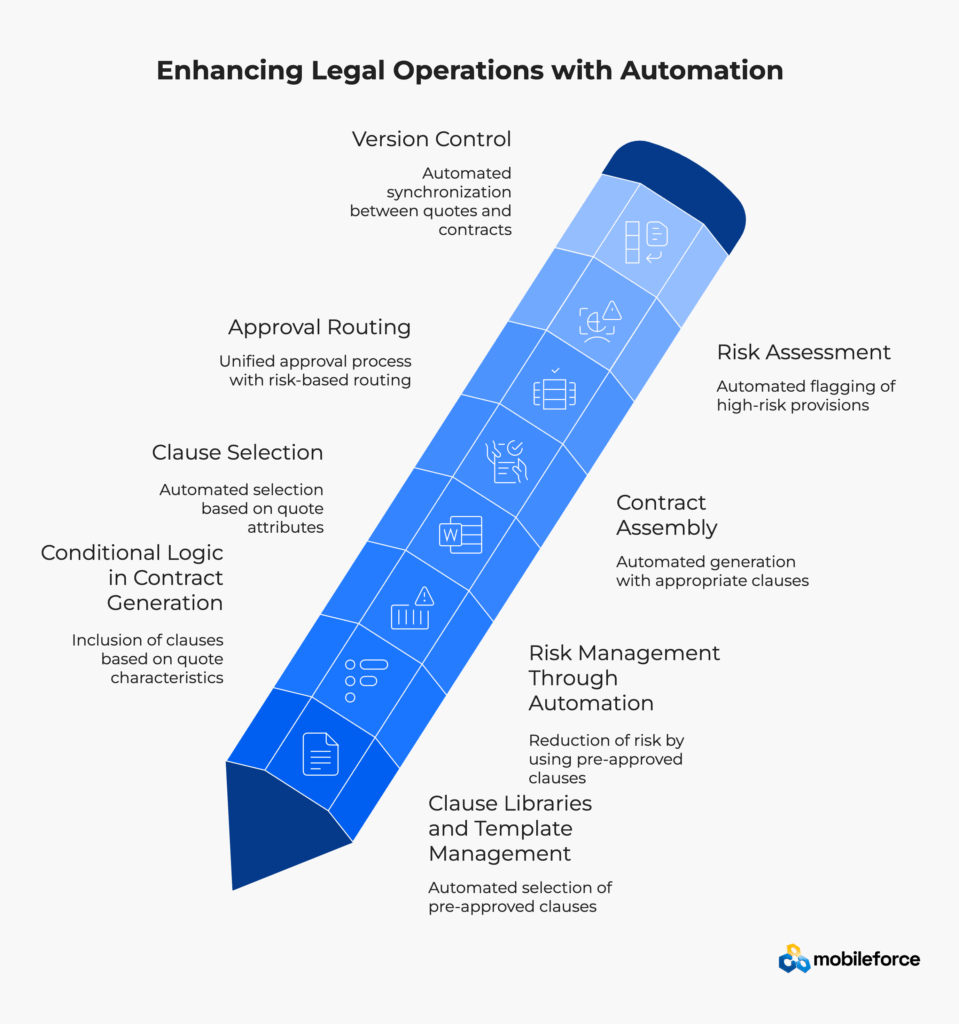
Mobileforce offers a unique perspective on CPQ-CLM integration, particularly for organizations with field operations. Their platform bridges the gap between on-site quoting and back-office contract processes, creating a seamless workflow regardless of connectivity challenges.
Mobileforce’s CPQ capabilities are designed with field operations in mind:
Mobile-First Design: The platform enables field technicians and sales representatives to configure complex products and services using mobile devices.
Offline Capabilities: Unlike many CPQ solutions, Mobileforce works in offline environments, allowing quotes to be generated even without connectivity.
Visual Configuration: Intuitive interfaces make it possible to configure complex products without specialized training.
As Mobileforce’s CPQ solution overview explains, “When field representatives can generate accurate quotes on-site, the entire quote-to-contract process accelerates dramatically.”
Seamless Handoff to Contract Processes
Once quotes are generated, Mobileforce facilitates their transition to contract processes:
Structured Data Output: Quotes are structured in a way that facilitates automatic contract generation.
Validation Rules: Built-in validation ensures quotes meet all requirements before initiating contract workflows.
Approval Routing: Context-aware approval workflows route quotes to appropriate stakeholders based on business rules.
For organizations with field service operations, Mobileforce’s field service management capabilities add another dimension to quote-to-contract processes:
On-Site Adjustments: Field technicians can modify quotes based on conditions discovered during service visits.
Customer Acceptance: Mobile interfaces enable immediate customer review and acceptance of quotes.
Documentation Capture: Supporting documentation (e.g., site photos, customer requirements) can be attached to quotes and flow through to contracts.
According to Mobileforce’s field service scheduling documentation, “When quote-to-contract processes are integrated with field service operations, organizations achieve both operational efficiency and enhanced customer experience.”
Organizations leveraging Mobileforce for quote-to-contract processes report several advantages:
Cycle Time Reduction: Customers report reducing quote-to-contract cycle times by up to 65% when field representatives can generate quotes on-site.
Error Reduction: By eliminating manual rekeying of quote data, error rates decrease by approximately 42%.
Customer Satisfaction: The ability to provide immediate quotes and initiate contract processes on-site leads to measurably higher customer satisfaction scores.
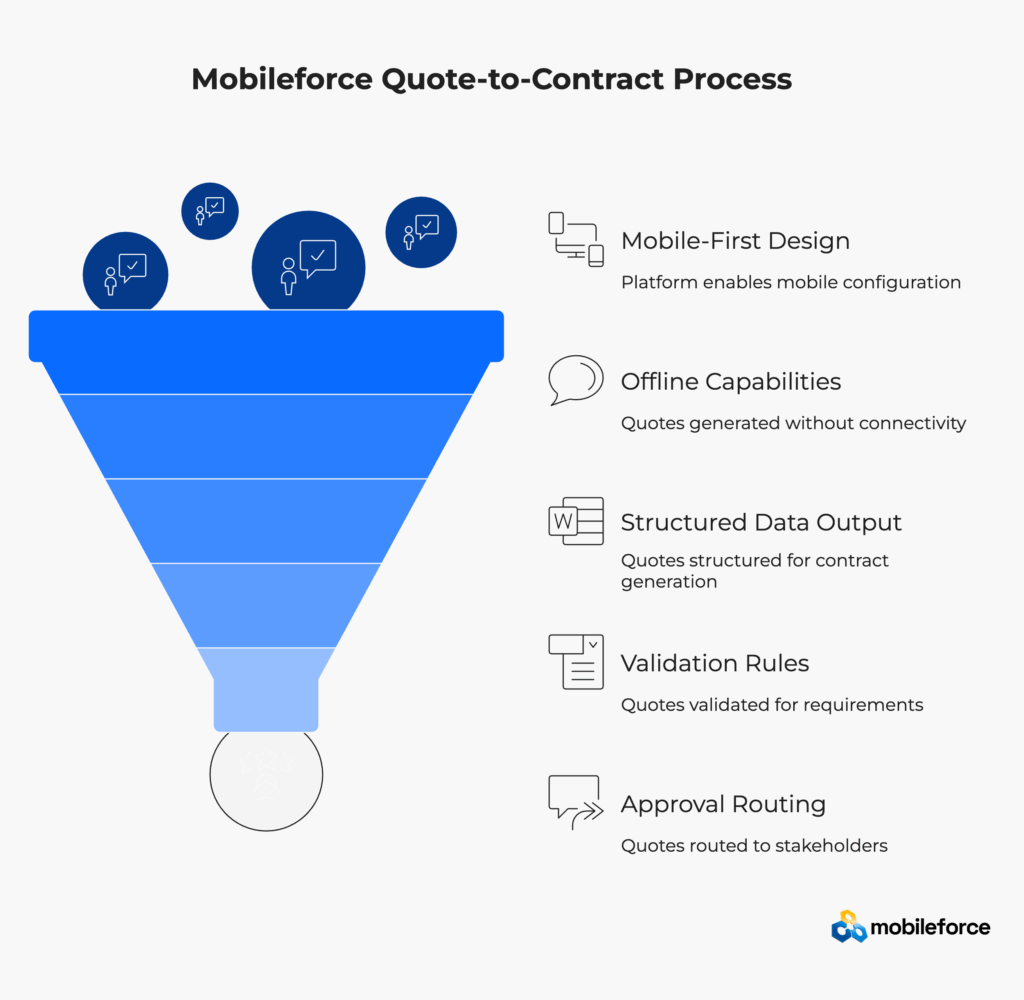
The integration of CPQ and CLM systems creates fertile ground for artificial intelligence and advanced automation. These technologies can transform quote-to-contract processes from simply efficient to truly intelligent.
Before quotes transition to contracts, AI can play a crucial role in validation:
Anomaly Detection: AI algorithms can identify unusual configurations, pricing, or terms that may indicate errors or require special attention.
Risk Assessment: Machine learning models can evaluate quotes against historical patterns to flag high-risk scenarios.
Optimization Recommendations: AI can suggest modifications to quotes that might increase win probability while maintaining profitability.
According to a recent Forrester study, organizations using AI for quote validation report a 34% reduction in quote-related contract issues.
Once quotes move to the contract phase, AI can enhance the contract generation process:
Clause Recommendation: Based on quote attributes, AI can recommend appropriate clauses beyond simple rule-based selection.
Language Optimization: Natural language processing can analyze contract language for clarity, compliance, and alignment with organizational standards.
Risk Highlighting: AI can identify potentially problematic contract provisions, flagging them for legal review.
The data generated throughout the quote-to-contract process provides valuable input for predictive analytics:
Cycle Time Prediction: Machine learning models can predict how long specific types of deals will take to move from quote to signed contract.
Approval Bottleneck Identification: Analytics can identify patterns in approval delays, enabling process optimization.
Win Probability Assessment: Based on quote attributes and contract negotiation patterns, AI can provide increasingly accurate win probability predictions.
Mobileforce’s AI-enhanced CPQ capabilities demonstrate how these technologies can be applied in field scenarios: “When field representatives receive AI-driven recommendations for product configurations and pricing, they can generate more accurate quotes that transition smoothly to contracts.”
Process Stage | Traditional Approach | AI-Enhanced Approach |
Quote Creation | Rule-based configuration | AI-recommended configurations based on success patterns |
Quote Validation | Manual review against guidelines | Automated anomaly detection and risk scoring |
Contract Generation | Template selection based on simple rules | Intelligent clause recommendation and optimization |
Approval Routing | Predefined workflows | Dynamic routing based on risk assessment |
Contract Analysis | Manual legal review | AI-assisted review with risk highlighting |
Ready to explore how AI can transform your quote-to-contract process? Schedule a Mobileforce demo to see these capabilities in action.
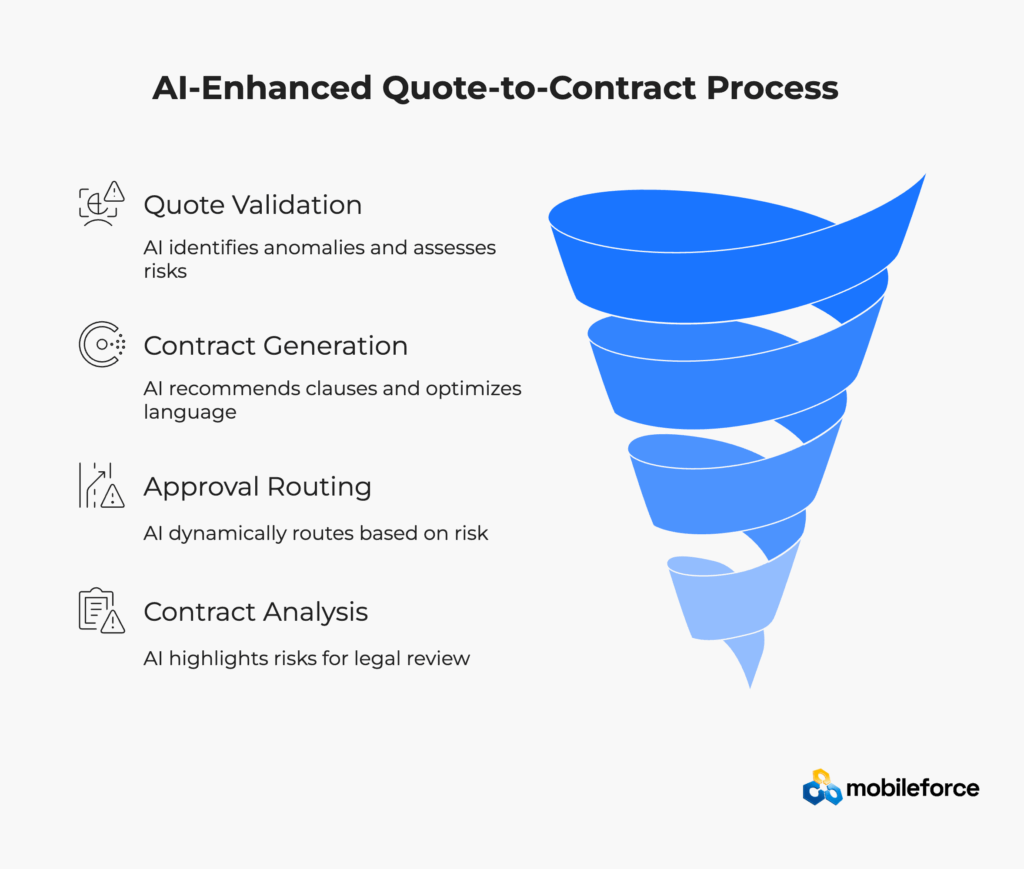
Implementing an integrated CPQ-CLM solution represents a significant investment. Measuring its success requires a comprehensive set of key performance indicators (KPIs) and a clear approach to calculating return on investment (ROI).
Organizations should track metrics across multiple dimensions:
Process Efficiency Metrics
Quality Metrics
Business Impact Metrics
According to research by Aberdeen Group, best-in-class organizations track at least 12 distinct KPIs across their quote-to-contract processes, compared to an industry average of just 5 metrics.
A comprehensive ROI calculation should consider both cost savings and revenue acceleration:
Cost Factors
Revenue Factors
Mobileforce’s ROI calculator for field operations provides a framework for assessing these benefits: “Organizations typically see ROI within 6-9 months of implementing integrated quote-to-contract processes, with the most significant gains coming from field operations.”
Before full-scale implementation, many organizations benefit from a focused pilot program:
Limited Scope: Select a specific product line, service category, or business unit.
Clear Baseline: Establish current performance metrics before implementation.
Defined Success Criteria: Set specific targets for improvement in key metrics.
Measurement Protocol: Determine how and when measurements will be taken.
Stakeholder Feedback: Incorporate qualitative feedback from users and customers.
A well-designed pilot typically runs for 60-90 days, providing sufficient data to validate expected benefits while identifying potential challenges before full deployment.
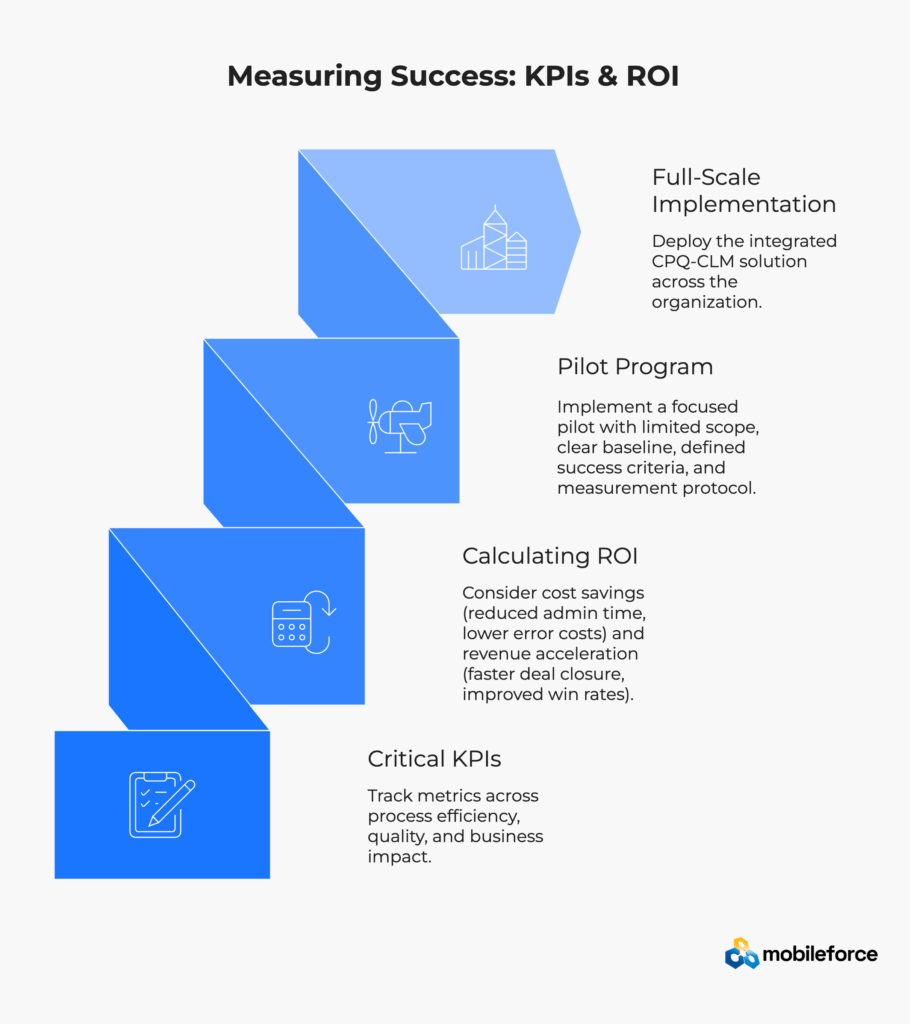
Once you understand the potential ROI, the next question becomes: how do you actually implement an integrated solution successfully?
Successfully implementing an integrated CPQ-CLM solution requires careful planning, stakeholder alignment, and a phased approach. Organizations that rush implementation often encounter resistance and fail to realize the full potential of these systems.
A staged implementation allows organizations to build momentum while managing change effectively:
First 30 Days: Foundation
Days 31-60: Core Implementation
Days 61-90: Expansion and Optimization
This phased approach minimizes disruption while allowing for adjustment based on early learnings.
Stakeholder Engagement and RACI
Successful implementation requires clear roles and responsibilities:
Mobileforce’s implementation approach emphasizes stakeholder engagement: “The most successful implementations involve key stakeholders from sales, legal, IT, and field operations from day one, ensuring the solution addresses each group’s specific needs.”
Data Migration and Validation
Data quality is critical to successful CPQ-CLM integration:
Training and Change Management
User adoption ultimately determines implementation success:
Ready to start your CPQ-CLM implementation journey? Schedule a Mobileforce demo to discuss your specific requirements and implementation approach.
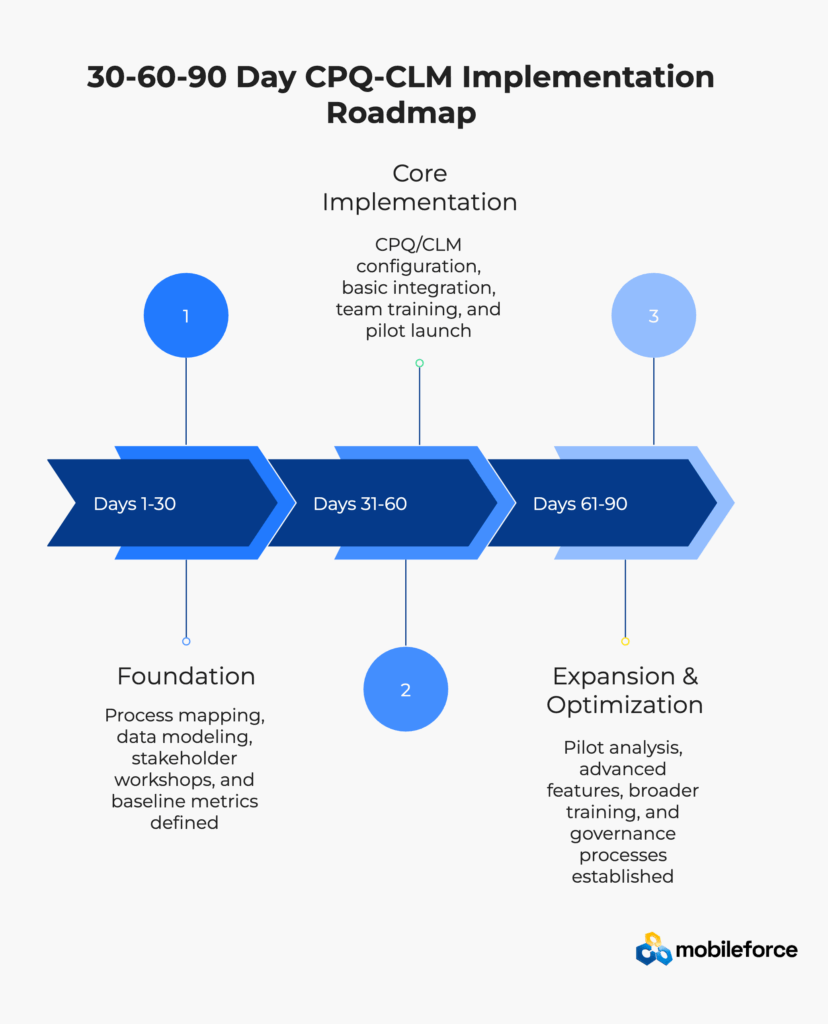
To illustrate the real-world impact of integrated quote-to-contract processes, consider this case study of a field service organization leveraging Mobileforce’s solutions.
National Equipment Services (NES) provides maintenance and repair services for industrial equipment across multiple industries. With over 500 field technicians serving customers nationwide, the company faced significant challenges in its quote-to-contract processes:
NES implemented Mobileforce’s integrated CPQ and Field Service Management solution with seamless handoff to their existing CLM system. Key components included:
Mobile CPQ for Field Technicians
Automated Handoff to Contracts
Analytics and Reporting
After six months of implementation, NES achieved significant improvements:
Process Efficiency
Business Impact
Field Team Benefits
As the Mobileforce field service management guide explains, “When field teams can generate quotes that automatically flow into contracts, they become more than service providers—they become true revenue generators for the organization.”
NES’s implementation yielded several valuable insights:
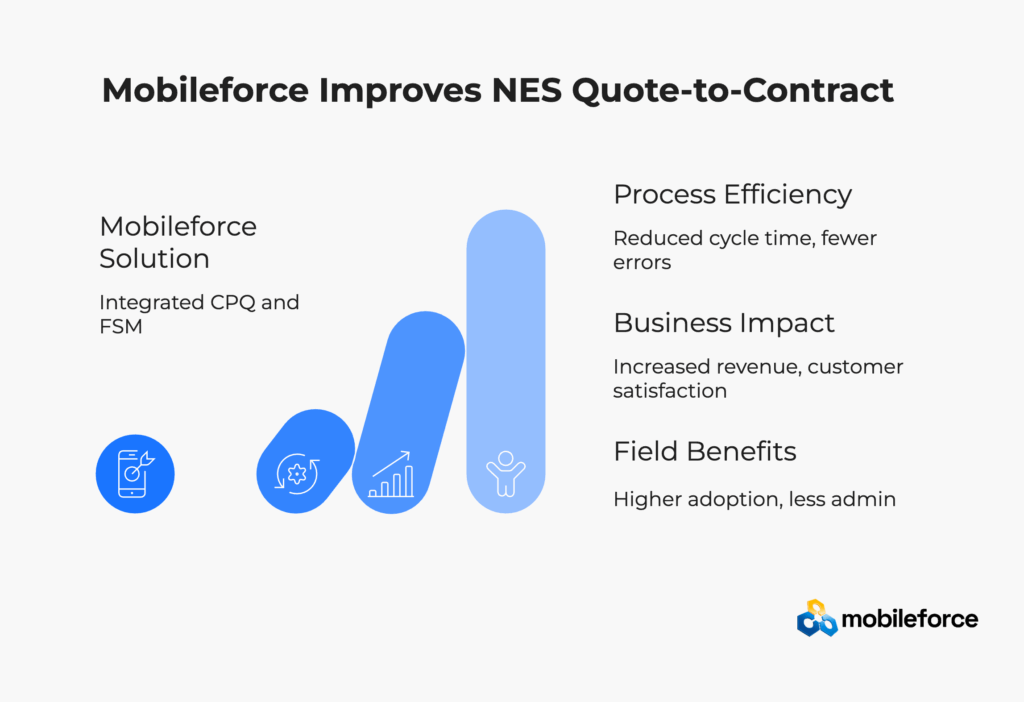
The connection between CPQ and CLM systems represents more than a technical integration—it bridges the traditional divide between sales and legal processes. When implemented effectively, this connection creates a seamless flow from initial customer interest to binding agreement, eliminating the friction that often causes deals to stall or fail.
Technology alone won’t solve quote-to-contract challenges. The most successful implementations combine sophisticated integration with thoughtful process design and committed change management. Organizations that view CPQ-CLM integration as simply “connecting two systems” miss the larger opportunity to reimagine how sales and legal teams collaborate.
For companies with field operations, the stakes are even higher. When technicians can generate quotes on-site that automatically flow into contract workflows, the entire customer experience transforms.
The question isn’t whether to integrate CPQ and CLM systems, but how quickly you can do it effectively. In today’s competitive environment, companies that can generate accurate quotes and execute contracts faster will win more deals, satisfy more customers, and grow more profitably.
The technology exists. The methodologies are proven. When will you bridge your quote-to-contract divide?
Transform your quote-to-contract process today. Schedule a Mobileforce consultation to explore how integrated CPQ-CLM solutions can accelerate your business growth.
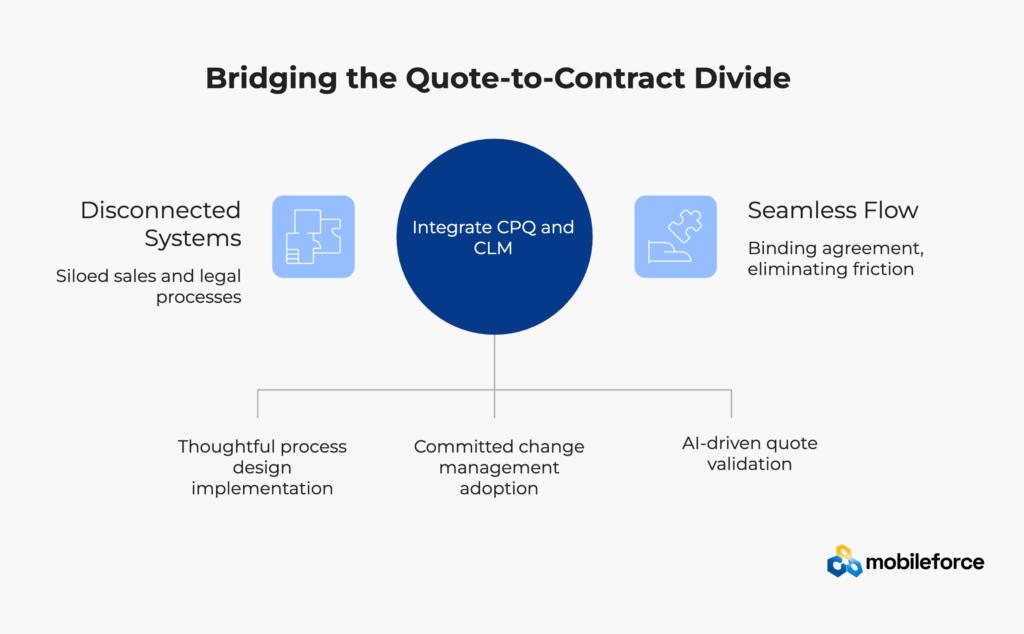
CPQ (Configure-Price-Quote) systems focus on helping sales teams configure products, apply pricing rules, and generate accurate quotes. CLM (Contract Lifecycle Management) systems help legal teams create, execute, and manage contracts throughout their lifecycle. While CPQ operates primarily in the pre-sale phase, CLM handles the formal agreement and post-execution management.
In an integrated environment, quote data—including product configurations, pricing, discounts, and terms—flows automatically into contract templates. This transfer typically occurs when a quote reaches “accepted” status, triggering the creation of a draft contract. The specific mechanisms vary based on integration approach (API, middleware, etc.), but the goal is to eliminate manual rekeying of information.
Yes, with solutions like Mobileforce that integrate mobile CPQ capabilities with contract processes. Field technicians can generate quotes on-site that automatically initiate contract workflows. Depending on complexity and approval requirements, simple contracts can be generated, approved, and executed during the same visit using e-signature technology.
Key performance indicators include quote-to-contract cycle time (how quickly quotes become executable contracts), error rates (discrepancies between quotes and contracts), approval efficiency (number of approval cycles), and contract compliance (how well deliverables match contracted terms). The most comprehensive measurement approaches include both efficiency metrics and business impact measures like revenue acceleration.
Modern CLM systems use rules engines that map quote attributes to appropriate clauses. For example, specific product categories might trigger warranty clauses, discount levels might require particular payment terms, and service options might call for specific service level agreements. Advanced systems may use AI to recommend clauses based on historical patterns and success rates.
Mobile CPQ solutions like Mobileforce are designed to function in offline environments, allowing quotes to be generated without connectivity. These systems typically store quote data locally and synchronize with central systems once connectivity is restored. Proper conflict resolution mechanisms ensure data integrity when multiple users make changes while offline.
AI enhances quote-to-contract processes through anomaly detection (identifying unusual configurations or terms), clause recommendation (suggesting appropriate contract language based on quote attributes), risk assessment (flagging potentially problematic terms), and predictive analytics (forecasting approval timelines and win probabilities). As AI capabilities advance, these systems are becoming increasingly proactive in optimizing both quotes and contracts.
A comprehensive ROI calculation should consider both cost savings (reduced administrative time, fewer errors, lower legal review costs) and revenue impact (faster closings, improved win rates, better renewal performance). Most organizations see positive ROI within 6-12 months, with field service operations typically realizing benefits faster due to the immediate impact on on-site quote generation and contract initiation.
Common challenges include incomplete data mapping between systems, inadequate handling of version control when quotes or contracts change, insufficient attention to approval workflows, poor user experience design, and failure to address offline/mobile scenarios. Organizations can mitigate these risks through careful planning, phased implementation, and selection of solutions with proven integration capabilities.
Mobileforce provides mobile-optimized CPQ capabilities that work both online and offline, allowing field personnel to generate accurate quotes regardless of connectivity. These quotes are structured to feed seamlessly into contract processes, with automated validation and approval routing. The platform’s field service management capabilities add additional context, enabling technicians to incorporate on-site observations into quotes and contracts.
Have more questions about how CPQ-CLM integration can benefit your organization? Schedule a personalized Mobileforce demo to discuss your specific requirements.
Request a Mobileforce demo and discover how unified CPQ + CLM can shorten your sales cycle.